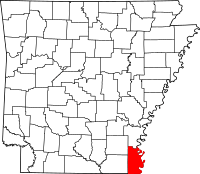Battle of Old River Lake facts for kids
Quick facts for kids Battle of Old River Lake |
|||||||
|---|---|---|---|---|---|---|---|
| Part of the Trans-Mississippi Theater of the American Civil War |
|||||||
 Chicot County, location of the Battle of Old River Lake |
|||||||
|
|||||||
| Belligerents | |||||||
| Commanders and leaders | |||||||
| Strength | |||||||
| 6,000 | 800 | ||||||
| Casualties and losses | |||||||
| 180 | 100 | ||||||
The Battle of Old River Lake, also known as Ditch Bayou, Furlough, and Fish Bayou, was a small fight during the American Civil War. It happened from June 5 to June 6, 1864. This battle was between soldiers from the U.S. Army (also called the Union) and soldiers from the Confederate army.
A Union army group marched into land held by the Confederates in Chicot County, Arkansas. The battle ended mostly in a tie. Both sides achieved some of their goals. The Confederate troops managed to slow down the Union army's advance. They also caused more injuries to the Union side than they received. At the same time, the Union troops successfully moved closer to their goal, which was Lake Village.
The Fight at Old River Lake
The main goal for the Confederate soldiers was to slow down the Union army. They knew they probably couldn't win a big battle against the larger Union force. Instead, they used small attacks and quick retreats. This way, they could slowly cause injuries to the Union Army. These tactics helped them try to stop the Union advance toward Lake Village.
In early June, Brigadier General Joseph Mower of the Union army got orders. His commander, Maj. Gen. Andrew J. Smith, wanted him to show that the Union planned to move toward Lake Village.
On the evening of June 5 and the morning of June 6, General Mower's troops began their march toward Lake Village. Soon, Confederate soldiers appeared. They would fire a few shots and then quickly pull back to safety. These retreating soldiers eventually joined General Colton Greene's main Confederate force. General Greene's troops, along with their cannons, tried to stop the Union advance.
After some fighting, the Confederates ended the battle and moved away to Parker's Landing. The Union troops continued to Lake Village. They camped there for the night. The next day, they met up with their boats on the Mississippi River at Columbia. Even though the Confederates had slowed them down, the Union troops still reached their target.
Images for kids



